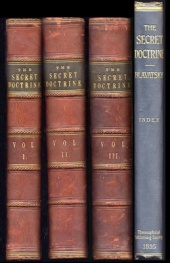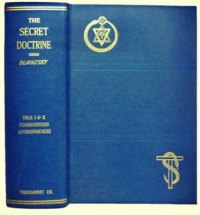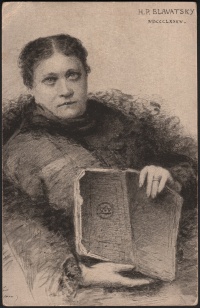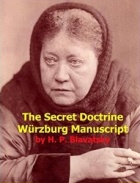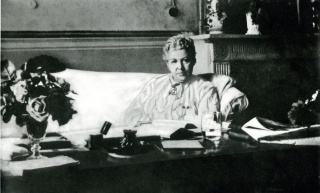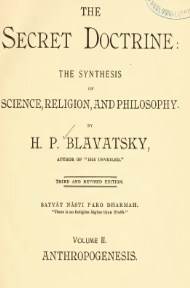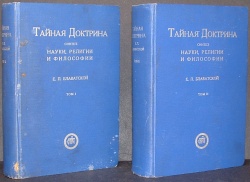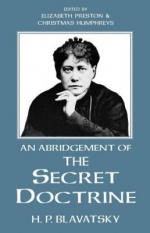The Secret Doctrine (book): Difference between revisions
| Line 98: | Line 98: | ||
:It seems that the sheets of the First Volume, most likely folded, were sent to [[William Quan Judge|W. Q. Judge]] in New York. The American edition was published in a dark brown and a dark blue binding, and bears the inscription: “Entered according to Act of Congress in the year 1888, by H.P. Blavatsky, in the Office of the Librarian of Congress at Washington, D.C.” facing the dedication.<ref>Helena Petrovna Blavatsky, ''Collected Writings'' vol. X (Wheaton, IL: Theosophical Publishing House, 1988), 157-158.</ref> | :It seems that the sheets of the First Volume, most likely folded, were sent to [[William Quan Judge|W. Q. Judge]] in New York. The American edition was published in a dark brown and a dark blue binding, and bears the inscription: “Entered according to Act of Congress in the year 1888, by H.P. Blavatsky, in the Office of the Librarian of Congress at Washington, D.C.” facing the dedication.<ref>Helena Petrovna Blavatsky, ''Collected Writings'' vol. X (Wheaton, IL: Theosophical Publishing House, 1988), 157-158.</ref> | ||
* '''Second edition in 2 vol., 1888'''. The 500 copies of the first printing of volume 1 were sold before date of publication to advance subscribers. This was followed by an immediate second impression, erroneously called “second edition”. It was only a second printing from the same plates, with a few minor inaccuracies rectified.<ref>Helena Petrovna Blavatsky, ''The Secret Doctrine'' vol. I, (Wheaton, IL: Theosophical Publishing House, 1993), [59].</ref> | * '''Second edition in 2 vol., 1888'''. The 500 copies of the first printing of volume 1 were sold before date of publication to advance subscribers. This was followed by an immediate second impression, erroneously called “second edition”. It was only a second printing from the same plates, with a few minor inaccuracies rectified.<ref>Helena Petrovna Blavatsky, ''The Secret Doctrine'' vol. I, (Wheaton, IL: Theosophical Publishing House, 1993), [59].</ref> According to printer [[James Morgan Pryse]], "the printing was done from the type, but stereotype matrices were made in case another should be called for. When that time came, however, we found that the matrices had been accidently destroyed; and I, for one, was decidedly pleased at their loss, since it made opportune a much needed revision of the text, which arduous labor was undertaken by Mr. Mead and Mrs. Besant."<ref>James Morgan Pryse, "An Important Statement by Mr. J. M. Pryse" ''The Messenger'' 14.6 (November, 1926), 125.</ref> | ||
[[File:1893 SD Vol II.jpg|right|200px|thumb|1893 edition]] | [[File:1893 SD Vol II.jpg|right|200px|thumb|1893 edition]] | ||
* '''Third and revised edition in 2 vol., 1893'''. The text in this edition was considerably revised, mainly by scholar and former secretary of [[Helena Petrovna Blavatsky|Mme. Blavatsky]], [[G. R. S. Mead]],<ref>See [http://www.blavatskyarchives.com/mead1.htm# Facts about ''The Secret Doctrine''] by G.R.S. Mead</ref> with some involvement of [[Annie Besant]]. The corrections involved imperfect English and grammatical errors; transliteration of foreign terms; changes in punctuation, capitalization and italics; some footnotes of the original edition were incorporated to the main text; and any reference to HPB's projected Third or Fourth volumes that never saw the light were eliminated. As a result of this, the pagination in this edition is different from the two previous.<ref>Helena Petrovna Blavatsky, ''The Secret Doctrine'' Index, (Wheaton, IL: Theosophical Publishing House, 1993), 476-477.</ref> This drew criticism in some quarters by students who claimed some changes are not justifiable. | * '''Third and revised edition in 2 vol., 1893'''. The text in this edition was considerably revised, mainly by scholar and former secretary of [[Helena Petrovna Blavatsky|Mme. Blavatsky]], [[G. R. S. Mead]],<ref>See [http://www.blavatskyarchives.com/mead1.htm# Facts about ''The Secret Doctrine''] by G.R.S. Mead</ref> with some involvement of [[Annie Besant]]. The corrections involved imperfect English and grammatical errors; transliteration of foreign terms; changes in punctuation, capitalization and italics; some footnotes of the original edition were incorporated to the main text; and any reference to HPB's projected Third or Fourth volumes that never saw the light were eliminated. As a result of this, the pagination in this edition is different from the two previous.<ref>Helena Petrovna Blavatsky, ''The Secret Doctrine'' Index, (Wheaton, IL: Theosophical Publishing House, 1993), 476-477.</ref> This drew criticism in some quarters by students who claimed some changes are not justifiable. | ||
| Line 108: | Line 109: | ||
* '''Index to the "Third and revised edition", 1895'''. This large and comprehensive Index prepared by [[A. J. Faulding|Mr. A. J. Faulding]] was published as a separate volume, substantially expanding the "Index to v. 1 & 2" in the first and second editions. A Concordance of pagination with the previous editions was included. The publishers were The Theosophical Publishing Society, London; ''The Path'' Office, New York; The Theosophical Publishing Society, Benares; and ''The Theosophist'' Office, Adyar. | * '''Index to the "Third and revised edition", 1895'''. This large and comprehensive Index prepared by [[A. J. Faulding|Mr. A. J. Faulding]] was published as a separate volume, substantially expanding the "Index to v. 1 & 2" in the first and second editions. A Concordance of pagination with the previous editions was included. The publishers were The Theosophical Publishing Society, London; ''The Path'' Office, New York; The Theosophical Publishing Society, Benares; and ''The Theosophist'' Office, Adyar. | ||
[[File:1993 Quest Books BdeZ edition.jpg|right|180px|thumb|1993 Quest Books edition, edited by [[Boris de Zirkoff]]]] | [[File:1993 Quest Books BdeZ edition.jpg|right|180px|thumb|1993 Quest Books edition, edited by [[Boris de Zirkoff]]]] | ||
=== Theosophical Publishing House === | === Theosophical Publishing House === | ||
* '''First edition of Volume 3, 1897'''. | * '''First edition of Volume 3, 1897'''. Annie Besant | ||
* '''Three-volume edition, 1911'''. Reprinted in 1913, 1918, 1921, and 1928. | * '''Three-volume edition, 1911'''. Reprinted in 1913, 1918, 1921, and 1928. | ||
Revision as of 20:17, 14 June 2016
The Secret Doctrine by Helena Petrovna Blavatsky lays the foundation of modern Theosophy. It is "one of the monuments of modern esotericism. Originally published in 1888, it gave the spiritual history of the development of the cosmos (or kosmos, as the author would have it) and of human life on earth. In doing this Mme. Blavatsky drew on her impressive knowledge of myth and ancient scripture for verification of the lineage of her theories. The book has gone on to become one of the most influentuial expositions of esoteric ideas, and its two volumes, comprising more than fifteen hundred pages, remain in print." [1]
Writing
H. P. Blavatsky is best known as the author of The Secret Doctrine, the crowning achievement of her literary endeavors. In May 1879, soon after moving to India to lead the establishment of the Theosophical Society, she began to draft the The Secret Doctrine. It was intended as an enlarged and improved rendering of Isis Unveiled which, according to the Master K. H., writing in 1882, "really ought to be re-written for the sake of the family honour," and in which everything is "hardly sketched — nothing completed or fully revealed."[2]
In January 1884 the Supplement to The Theosophist published an advertisement announcing that "a New Version of Isis Unveiled," which was to be published as monthly articles. Although Mme. Blavatsky had some written material to start the monthly installments, this plan never came to fruition in the way planned, due to ill-health, her travel to Europe, and the Coulomb affair.
In the fall of 1885, a few months after HPB moved to Wurzburg, Germany, she started working steadily on writing. The Countess Wachtmeister moved with HPB to help in this endeavor. As the writing of the book developed with the help of Masters M. and K.H., HPB realized it was much more than a rewriting of Isis Unveiled. In a letter to A. P. Sinnett she said she felt that this could vindicate the Theosophical Society after the unfavorable Report that Richard Hodgson had made.[3]
In the spring of 1886 she sent a preliminary manuscript of the first volume to Adyar, where T. Subba Row was supposed to read it and contribute additional material related to Hindu philosophy. However, he refused to do so. HPB moved to Ostende, Belgium, where she continued working on the book.
By the end of March 1887 she fell gravely ill with a kidney infection, and was not expected to live. Master Morya came at night and asked her if she wanted to be freed from the body, or to live, with much suffering, to finish The Secret Doctrine. She agreed to finish the book. On May 1, 1887, she moved to London where a group of earnest students helped her to prepare the huge manuscript for publication.
The First Volume of The Secret Doctrine came off the press on October 20, 1888 and all 500 copies were sold out before the date of publication. The Second Volume came out towards the end of the year.
Wurzburg manuscript
Some of the original manuscript was not included in the first two volumes published. Portions have been lost, but through the scholarship of David and Nancy Reigle, the Würzburg Manuscript of The Secret Doctrine was finally published in 2014. According to the editors:
It includes H. P. Blavatsky’s first translations of stanzas from the Book of Dzyan with her unrevised commentaries on them. Only the stanzas from the Würzburg manuscript had been published until now, not her unrevised commentaries on them. These comprise cosmogenesis, and a few on anthropogenesis. The Würzburg manuscript also includes a large introductory section, comprising about half the book. Most of the chapters in this introductory section were later published in the 1897 third volume of The Secret Doctrine. As with the commentaries on the stanzas, here we have her unrevised versions.
The so-called Würzburg manuscript is a partial copy of Blavatsky’s early manuscript of The Secret Doctrine, written while she was staying at Würzburg, Germany, and then at Ostende, Belgium, in 1885 and 1886. Her manuscript of the almost completed Secret Doctrine was copied by two or more scribes to send to India for revision by T. Subba Row, which revision did not occur. Only part of this copy has been found. What we have is estimated to be about a fourth or a third of the whole that was sent to India. Fortunately, it includes the whole cosmogenesis section, all seven stanzas and their commentaries.[4]
Review by Annie Besant
In 1889, W. T. Stead, the famous Editor of the Pall Mall Gazette and founder of the journal Review of Reviews, gave Annie Besant two large volumes of The Secret Doctrine, asking her if she could review them. "My young men all fight shy of them, but you are quite mad enough on these subjects to make something of them." She wrote the review and published in The Pall Mall Gazette (London) on April 25, 1889. It was reprinted in August of that year in The Theosophist, and is available at The Blavatsky Archives Online.
She described her experience in reading the book as follows:
As I turned over page after page the interest became absorbing; but how familiar it seemed; how my mind leapt forward to presage the conclusions, how natural it was, how coherent, how subtle, and yet how intelligible. I was dazzled, blinded by the light in which disjointed facts were seen as parts of a mighty whole, and all my puzzles, riddles, problems, seemed to disappear. The effect was partially illusory in one sense, in that they all had to be slowly unravelled later, the brain gradually assimilating that which the swift intuition had grasped as truth. But the light had been seen, and in that flash of illumination I knew that the weary search was over and the very Truth was found.[5]
Her review opens with these words:
It would be difficult to find a book presenting more difficulties to the "reviewer with a conscience" than these handsome volumes bearing the name of Mdme. Blavatsky as author --- or, perhaps, it would be more accurate to say, as compiler and annotator. The subject-matter is so far away from the beaten paths of literature, science, and art; the point of view so removed from our Occidental fashion of envisaging the universe; the lore gathered and expounded so different from the science or the metaphysics of the West, that to ninety-nine out of every hundred readers --- perhaps to nine hundred and ninety-nine among every thousand --- the study of the book will begin in bewilderment and end in despair.[6]
Structure of The Secret Doctrine
The Secret Doctrine was originally published in two volumes, with three parts to each volume. Boris de Zirkoff explained its contents as follows:
The skeleton of Book I is formed by Seven Stanzas translated from the secret Book of Dzyan, the original of which is written in the sacred language of the Initiates—the Senzar. The stanzas and their commentaries and explanations form Part I of this First Book. Part II is devoted to the elucidation of the fundamental symbols contained in the great religions of the world, and the occult meaning of the hidden ideographs and glyphs. Part III outlines the contrasting views of Science and the Secret Doctrine and meets probable scientific objections by anticipation. This Part serves as a connecting link between the two volumes.
The general arrangement of Volume II is similar to that of Volume I. It deals primarily with the Evolution of Man on this Planet. Part I is based on Twelve Stanzas from the Book of Dzyan describing the gradual evolution of humanity through many occult stages, the origin of the lower kingdoms of nature, the submergence of ancient continents, and presents a panoramic view of bygone civilizations. Part II deals with the Archaic Symbolism of the World-Religions, with special emphasis on the Sevenfold and Quaternary classifications of elements and forces. Part III contrasts again the teachings of the Wisdom-Religion with those of the then current Science, mainly in the domain of Anthropology and Geology.[7]
Below are the titles of the main sections:
|
|
Study of The Secret Doctrine
Commander Robert Bowen was a personal student of Madame Blavatsky in London. On April 19, 1891, he wrote notes about her recommendations for how to study The Secret Doctrine:
H. P. B. was specially interesting upon the matter of The Secret Doctrine during the past week. I had better try to sort it all out and get it safely down on paper while it is fresh in my mind. As she said herself, it may be useful to someone thirty or forty years hence...
First of all then, The Secret Doctrine is only quite a small fragment of the Esoteric Doctrine known to the higher members of the Occult Brotherhoods. It contains, she says, just as much as can be received by the World during this coming century...
Reading the SD page by page as one reads any other book (she says) will only end in confusion. The first thing to do, even if it takes years, is to get some grasp of "Three Fundamental Principles" give in Proem. Follow that up by study of the Recapitulation - the numbered items in the Summing up to Vol. I (Part 1). Then take the Preliminary Notes (Vol. II) and the Conclusion (Vol. II). [8]
See Robert Bowen Notes for the complete text.
Editions
- First edition in 2 vol., 1888. The first volume was published on October 20. The second volume was published towards the end of the year. Both volumes have a greyish binding bearing in the usual place the imprint: Theosophical Publishing Co., Ltd., London. They bear the inscriptions: "Printed by Allen Scott and Co., 30, Bouverie Street, E.C." facing the title-page; and "Entered at Stationer’s Hall. All Rights Reserved" facing the dedication.
- It seems that the sheets of the First Volume, most likely folded, were sent to W. Q. Judge in New York. The American edition was published in a dark brown and a dark blue binding, and bears the inscription: “Entered according to Act of Congress in the year 1888, by H.P. Blavatsky, in the Office of the Librarian of Congress at Washington, D.C.” facing the dedication.[9]
- Second edition in 2 vol., 1888. The 500 copies of the first printing of volume 1 were sold before date of publication to advance subscribers. This was followed by an immediate second impression, erroneously called “second edition”. It was only a second printing from the same plates, with a few minor inaccuracies rectified.[10] According to printer James Morgan Pryse, "the printing was done from the type, but stereotype matrices were made in case another should be called for. When that time came, however, we found that the matrices had been accidently destroyed; and I, for one, was decidedly pleased at their loss, since it made opportune a much needed revision of the text, which arduous labor was undertaken by Mr. Mead and Mrs. Besant."[11]
- Third and revised edition in 2 vol., 1893. The text in this edition was considerably revised, mainly by scholar and former secretary of Mme. Blavatsky, G. R. S. Mead,[12] with some involvement of Annie Besant. The corrections involved imperfect English and grammatical errors; transliteration of foreign terms; changes in punctuation, capitalization and italics; some footnotes of the original edition were incorporated to the main text; and any reference to HPB's projected Third or Fourth volumes that never saw the light were eliminated. As a result of this, the pagination in this edition is different from the two previous.[13] This drew criticism in some quarters by students who claimed some changes are not justifiable.
- This widely circulated edition was published by The Theosophical Publishing Society, London; The Path Office, New York; and The Theosophist Office, Adyar, and printed by the H.P.B. Press, London.[14]
- This edition was reprinted by the Theosophical Society (Adyar) in 1902, 1905, 1908, 1911.
- Index to the "Third and revised edition", 1895. This large and comprehensive Index prepared by Mr. A. J. Faulding was published as a separate volume, substantially expanding the "Index to v. 1 & 2" in the first and second editions. A Concordance of pagination with the previous editions was included. The publishers were The Theosophical Publishing Society, London; The Path Office, New York; The Theosophical Publishing Society, Benares; and The Theosophist Office, Adyar.
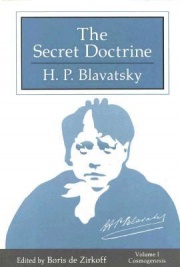
Theosophical Publishing House
- First edition of Volume 3, 1897. Annie Besant
- Three-volume edition, 1911. Reprinted in 1913, 1918, 1921, and 1928.
- Fourth (Adyar) edition, 6 vol., 1938. Volume five of this edition contains the text of the 1897 Volume 3, and volume six is an Index. Many of the footnotes introduced into the text in 1893 were restored as footnotes, and the few left in the text were enclosed in square brackets. This edition was reprinted in London in 1950.
- Fifth (Wheaton) edition, 6 vol., 1946. (By the Theosophical Press in Wheaton, Ill.)
- Sixth (Wheaton) edition, 6 vol., 1952. (By the Theosophical Press in Wheaton, Ill.)
- Fifth (Adyar) edition, 6 vol., 1962.
- Sixth (Adyar) edition, 6 vol., 1971. Published by Theosophical Publishing House (Adyar) and Theosophical Publishing House (Wheaton) with orange & white book jackets.
- Centenary Edition, 1988. Edited by Boris de Zirkoff in two volumes and Index, it follows the text and pagination of the original edition. Reprinted in 1993.
Theosophical University Press
In 1909 a new edition of Volumes I and II of The Secret Doctrine was produced by the Aryan Theosophical Press, Point Loma, California (since then moved to Covina, California, and known as the Theosophical University Press) under the direction of Katherine Tingley. This is virtually a reprint of the original 1888 edition with a scholarly transliteration of Sanskrit words according to an accepted standard, some corrections of faulty Greek and Latin and of obvious typographical errors, and the occasional substitution of square brackets in place of parentheses for clearness. No changes were made in H. P. Blavatsky's language and no passages were eliminated. This is the standard edition still being published by the Theosophical University Press, Covina.[15]
The 1909 edition was reprinted in 1917 as Second Point Loma edition, bound in four volumes, and a Third Point Loma edition took place in 1925 (bound in two and four volumes), all published by the Aryan Theosophical Press.
The Fourth edition was published by the Theosophical University Press, Covina, California, in 1947, as a reprint of the 1925 edition. The edition of 1952 is verbatim with the original 1888 edition. This was reprinted in The Netherlands in 1963 and 1970, and in the United States in 1974.
The Theosophy Company
The Theosophy Company of Los Angeles published in 1925 a photographic facsimile of the two volumes of The Secret Doctrine, bound in one volume. This edition provides the opportunity to study the work in exactly the way the author wrote it, although this edition perpetuates many typographical errors.[16] Several printings of it were issued in subsequent years.
Translations
The Secret Doctrine has been translated into numerous languages, including the following editions:
- Danish
- Den hemmelige lære: en syntese af videnskab, religion og filosofi was published in 1975 by Strube.
- Dutch
- A. Terwiel translated De geheime leer: de samenvatting van wetenschap, godsdienst en wijsbegeerte, which was published in Amsterdam by Theosofische Uitgeversmaatschappij, 1907-1911 and 1923.
- French
- La doctrine secrète: synthèse de la science, de la religion & de la philosophie was published in several editions by La Famille Théosophique in Paris.
- German
- The Franz Hartmann translation, GrundriB der Geheimlehre, was published by Theosophisches Verlagshaus, Leipzig, in 1919.
- Robert Froebe's translation,Die Geheimlehre : die Vereinigung von Wissenschaft, Religion und Philosophie', was published in Leipzig by Friedrich in 1900 and reissued in 1919 by Theosophisches Verlagshaus.
- Japanese
- Shikuretto dokutorin uchu hasseiron was translated by Emiko Tanka and Jeff Clark and published by Shinchigaku Kyokai Nippon Rojji of Tokyo in 1989. It is available at Hathitrust.
- Shikuretto dokutorin o yomu was translated by Masato Tojo and published in Tokyo by Shuppanshinsha in 2001.
- Portuguese
- A doutrina secreta: síntese de ciência, filosofia e religião' was published in São Paulo, Brasil by Pensamento in 1995.
- Russian
- E. I. Rerikh, or Helena Ivanovna Roerich, wife of painter Nicholas Roerich, translated Tainaia doktrina: sintez nauki, religii i filosofii in the early 1930s. She was able to complete the translation in less than two years due to her great proficiency with languages. Her edition was published in Moscow, St. Petersburg, and Riga. A 1900 edition shows A P. Hadock as a co-translator.
- Ezotericheskoe uchenie : Tainaia doktrina, t. III : kliuch k tainam drevnei i sovremennoi nauki i teologii was translated by K. I. U. Leonov. It was published in 1993 in Moscow by Rossiiskoe teosofskoe obshchestvo.
- Spanish
- Don José Xifré of Spain, a personal pupil of Helena Petrovna Blavatsky, published a Spanish translation in 1895-98, but almost every copy was destroyed by the Roman Catholic Church, according to Boris de Zirkoff.[17]
Writings and teachings on The Secret Doctrine
Theosophists worldwide have written and lectured about The Secret Doctrine. Over 1800 articles are listed in the Union Index of Theosophical Periodicals giving reviews, excerpts, quotations, and analyses of the books' contents. That count is based only on the term "Secret Doctrine," and searching on additional terms reveals a vast periodical literature dealing with Blavatsky's masterwork.
Abridgements
Several authors have attempted to make The Secret Doctrine more accessible by creating abridgements and commentaries.
- Gomes, Michael, Ed. The Secret Doctrine: The Classic Work by H. P. Blavatsky, abridged and annotated. New York: Jeremy P. Tarcher/Penguin, 2009.
- "This single-volume edition, abridged and annotated by historian and Theosophical scholar Michael Gomes, places the ideas of The Secret Doctrine within reach of all who are curious. In particular, Gomes provides a critical sounding of the book's famous stanzas on the genesis of life and the cosmos - mysterious passages that Blavatsky said originated from a primeval source and which form the heart of The Secret Doctrine. Gomes scrupulously scales down the book's key writings on symbolism to their essentials, and offers notes and a glossary to illuminate arcane references. His historical and literary introduction casts new light on some of the book's sources and on the career of its brilliant and elusive author, one of the most intriguing personages of recent history. At once compact and representative of the work as a whole, this new edition of The Secret Doctrine brings unprecedented accessibility to the key esoteric classic of the modern era." [18]
- Preston, Elizabeth, and Humphreys, Christmas. An Abridgement of The Secret Doctrine. London: Theosophical Publishing House, 1966.
- "This book is the product of a team of scholars from many parts of the theosophical world. It can be regarded as an introduction to the complete work, but it is not a substitute for it. The Abridgement contains the basic principles in the actual words of Mme. Blavatsky from the 1888 edition ot THE SECRET DOCTRINE; matters that the compilers consider to be in these days of secondary importance have been left out." [19] This abridgement was translated into German in 1984.
Commentaries
- Barborka, Geoffrey A. The Divine Plan – Written in the Form of a Commentary on H. P. Blavatsky's Secret Doctrine – Expressly for the Purpose of Those Who Wish to Read and Gain a Deeper Understanding of “The Secret Doctrine” – Presenting an Exposition of the Doctrines of the Esoteric Philosophy Analysing and Explaining All the Terms Used. Adyar: The Theosophical Publishing House, 1961.
- Barborka presents an exposition of the esoteric doctrines of Cosmogenesis from Volume I of The Secret Doctrine, analyzing and explaining all the terms used. The Divine Plan is a particularly useful commentary, and stands as a classic of Theosophical literature in its own right.
- Gomes, Michael, Ed. The Secret Doctrine Commentaries: The Unpublished 1889 Instructions. The Hague: I.S.I.S. Foundation, 2010.
- "Immediately after The Secret Doctrine was published, Blavatsky assembled a small group of students, at the Blavatsky Lodge in London, for more in depth inquiry and study of the ideas in the book. The Secret Doctrine Commentaries contains the never before published transcription of the shorthand notes of these Blavatsky Lodge meetings. Here is Blavatsky in dialogue with her students: Provocative, insightful, spontaneous, and inspiring of the deeper meaning. It offers a unique opportunity to read Blavatsky’s direct, prescient answers to questions on Cosmogenesis, Fohat, the infinitude of the Atom, the nature of Consciousness etc., giving the reader the impression of participating in these Blavatsky Lodge meetings themselves." [20]
Lectures and courses
See also
- Book of Dzyan
- Stanzas of Dzyan
- Three Fundamental Propositions
- Recapitulation
- Robert Bowen Notes
- Concepts in The Secret Doctrine
Online resources
Articles and pamphlets
- The Secret Doctrine as a Contribution to World Thought by Sri Madhava Ashish
- Second book Review of The Secret Doctrine by Annie Besant
- Mistaken Notions on the Secret Doctrine by H. P. Blavatsky
- Authorship of Secret Doctrine by William Q. Judge
- Hidden Hints in the Secret Doctrine - Part I and Part II by William Q. Judge
- The Secret Doctrine by Alvin Boyd Kuhn
- Study Course on The Secret Doctrine by Pablo Sender
- Book of Dzyan Studies by various contributors on Theosophy.net
- Compilation of articles related to the First Fundamental Proposition, Second Fundamental Proposition, and Third Fundamental Proposition at Philaletheians.co.uk
Books
- Transactions of the Blavatsky Lodge at ULT Phoenix's website
- The Secret Doctrine Dialogues at ULT Phoenix's website
- The Secret Doctrine Commentaries at Point Loma Blavatsky House Website
- Reminiscences of H.P. Blavatsky and The Secret Doctrine by Countess Constance Wachtmeister
Audio
- Introduction to the Study of The Secret Doctrine - Part 1, Part 2, Part 3, Part 4, Part 5, Part 6 by Ed Abdill
- Secrets of The Secret Doctrine W. Doss McDavid
- Important Principles in The Secret Doctrine - Part 1, Part 2, Part 3, Part 4, Part 5 by Joy Mills
Video
- Foundations of the Ageless Wisdom (5 Parts) by Ed Abdill
- The Secret Doctrine: Esoteric Insights and Spiritual Practice (8 Parts) by Pablo Sender
Bibliographies
Websites
- About The Secret Doctrine Compilation of material at Blavatsky Net
- Index to The Secret Doctrine Theosophical University Press online edition prepared by John P. Van Mater.
- An Invitation to The Secret Doctrine Includes The Secret Doctrine and Its Study by Robert Bowen, The Writing of The Secret Doctrine by Kirby Van Mater, and a Glossary of Terms by the Theosophical University Press
- The Secret Doctrine Theosophical University Press online edition
Notes
- ↑ Gomes, Michael, Ed., The Secret Doctrine: The Classic Work by H. P. Blavatsky, abridged and annotated, (New York: Jeremy P. Tarcher/Penguin, 2009), ix.
- ↑ Some Notes on The Secret Doctrine by Charles J. Ryan
- ↑ A. Trevor Barker, The Letters of H. P. Blavatsky to A. P. Sinnett Letter No. CXVI, (Pasadena, CA: Theosophical University Press, 1973), 79.
- ↑ Posting by David and Nancy Reigle to Theos-Talk discussion group. May 5, 2014.
- ↑ Annie Besant, An Autobiography (Adyar, Madras: Theosophical Publishing House, 1984), 310.
- ↑ [The Blavatsky Archives Online].
- ↑ Boris de Zirkoff, “What is The Secret Doctrine”, Theosophia XXV:1
- ↑ Robert Bowen, notes on "The Secret Doctrine and Its Study", April 19, 1891. Notes recorded less than three weeks before the death of Madame Blavatsky.
- ↑ Helena Petrovna Blavatsky, Collected Writings vol. X (Wheaton, IL: Theosophical Publishing House, 1988), 157-158.
- ↑ Helena Petrovna Blavatsky, The Secret Doctrine vol. I, (Wheaton, IL: Theosophical Publishing House, 1993), [59].
- ↑ James Morgan Pryse, "An Important Statement by Mr. J. M. Pryse" The Messenger 14.6 (November, 1926), 125.
- ↑ See Facts about The Secret Doctrine by G.R.S. Mead
- ↑ Helena Petrovna Blavatsky, The Secret Doctrine Index, (Wheaton, IL: Theosophical Publishing House, 1993), 476-477.
- ↑ Some Notes on The Secret Doctrine by Charles J. Ryan
- ↑ Some Notes on The Secret Doctrine by Charles J. Ryan
- ↑ Some Notes on The Secret Doctrine by Charles J. Ryan
- ↑ Boris de Zirkoff letter to Willamay Pym. January 1, 1979. Boris de Zirkoff Papers. Records Series 22. Theosophical Society in America Archives.
- ↑ Gomes, Michael, Ed., The Secret Doctrine: The Classic Work by H. P. Blavatsky, abridged and annotated, (New York: Jeremy P. Tarcher/Penguin, 2009), from the book jacket.
- ↑ Advertisement in supplement to The Theosophical Journal, Jan-Feb 1966.
- ↑ Gomes, Michael, Ed., The Secret Doctrine Commentaries: The Unpublished 1889 Instructions, (The Hague: I.S.I.S. Foundation, 2010), from the book jacket.
